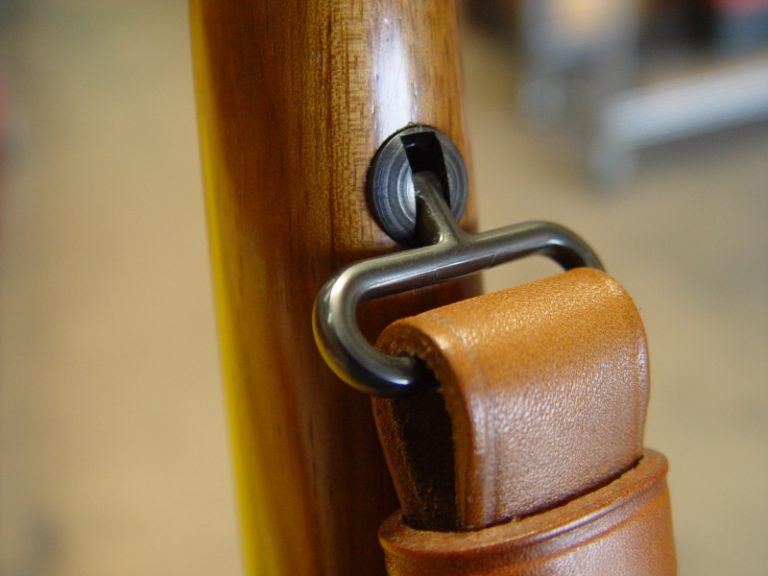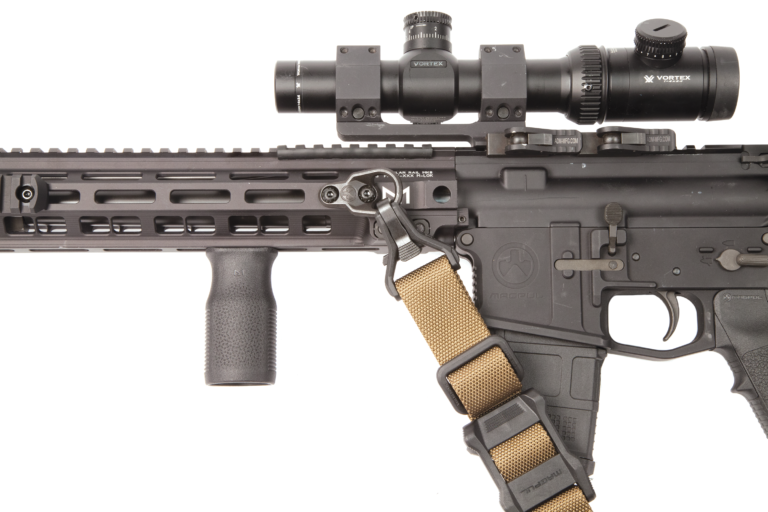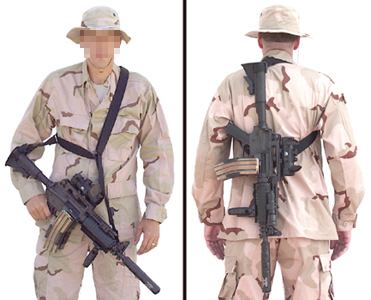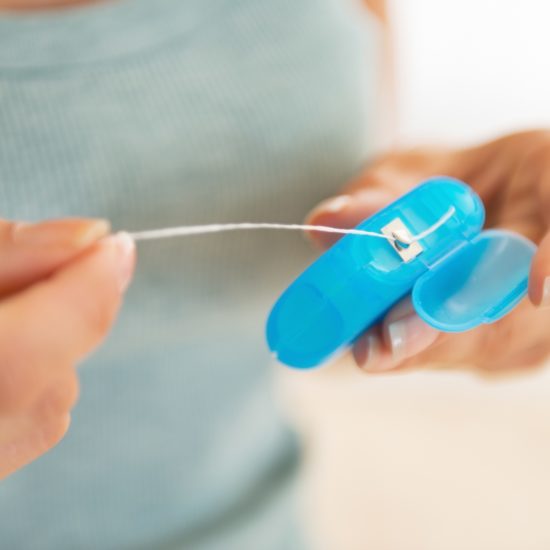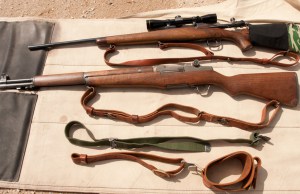
Early long guns could be carried in two hands ready for instant use or in one hand for almost as quick use. But you really could not do anything else with that hand or those hands. It became quickly obvious that a hands-free way of carrying a long gun was needed, and probably the first sling was simply a piece of rope tied to each end of the gun. Times have changed and today this article will be begin with some history, but will also share how to choose the best rifle sling for your use.
Introduction to Slings (Part 1)
In the late 17th century, as European militaries were arming more and more men with muskets, sling “swivels” started to appear on military firearms. Generally this was a slotted ring on the bottom of the stock near the butt, and a matching ring on the underside of the forend. A flat strap, usually of canvas, was then threaded through these rings. There was generally some length adjustment ability. In the 1870’s, a new U.S. military rifle was introduced which came with a fairly new concept: a sling made of leather.
As the experience with slings became more common, people found that besides allowing for hands-free carry, a properly set up and fitted sling could help achieve greater accuracy. The model 1907 sling was the height of sling development as far as support while shooting goes, where the forward arm is inserted between the straps of the sling and “locked” in place with “keepers”. Despite efforts to replace it, this model continued to be an official U.S. Military option until the days of the M16, which came with a simple adjustable nylon strap, returning the sling to a mere carrying device.
Note that even with a sling which is designed only for carrying, there is a technique of wrapping the sling around your forward arm which provides some of the stability of a M1907 style sling. This technique is called “hasty sling” because it is pretty quick and doesn’t require a lot of adjustment.
Originally the sling attachment points, and thus the slings, were usually along the bottom of the gun. This was not really a problem with early firearms, but as magazine fed guns started to appear, the sling and the magazine tended to interfere with each other a bit. Slings along the side of the gun could fix this problem, but were by no means ambidextrous and did not work as well for shooting support.
Quick Disconnect Mounts
Civilian shooters preferred a sling which could be easily attached and detached, encouraging the development of quick detach sling attachments. The strap is threaded through the QD attachments, which then can be easily attached to or removed from the matching mounts on the gun. Nowadays there appear to be at least five possible true QD options to put on the end of your sling.
Which of these options can be used on a particular gun depends on what mounts are built-in or added to that gun. It is optimal to have the same QD attachment on both ends of the sling, but it is not a requirement if having mismatched attachments is appropriate. It is handy to have the same mount or set of mounts on similar guns, so you don’t necessarily have to have a separate sling for each one.
STUD Mount
One of the first choices was “studs” screwed into the wood or clamped around the barrel. There was a hole through this stud and flat sides perpendicular to the hole, and the matching part had two flat flanges separated by the width of the stud, with a pin through them. Attached, there was a flange on each side of the stud and the pin through the flanges and the stud. Uncle Mikes has an extensive history with these swivels and still have a good selection. They are pretty good on sporting arms, but for tactical use they are not optimal. Early models could be “popped off” as the moving flange was merely spring-loaded. Some later models have a threaded knob, which when screwed down to the flange, prevents it from unintentionally opening.
CUP or HOLE Mount
Another early option was a “cup” inlet into the stock with a groove around near the top. The matching part had some small balls around the circumference, which clicked into these grooves. A button in the center retracted the balls so the part could be removed. An alternative mount to the cup is a hole in a piece of metal of the same thickness as the distance from the top of the cup to the groove. This system is fairly heavy-duty and can rotate side to side, which can be both good and bad. A few have built-in stops to prevent complete rotation, keeping the sling from getting twisted.
RING Mount
The M-LOK Paraclip Sling Mount is the M-LOK compatible variant of the older MSA – MOE Sling Attachment.
More recently, rings started appearing on tactical guns. These can accept a quick connect hook, and there appears to be three common choices. There is the Magpul Paraclip, slightly similar to a clothespin. This is fairly bulky; on the one hand, it does not fit on smaller rings, but on the other hand, is very stable. If it comes with a cross-bar lock (and you use it), it is highly resistant to unintentional release and even without using the lock I have not had a problem. Next is the HK snap clip. This is very versatile and flexible, but is a bit noisy and floppy, and if you twist it right, it can pop off by itself. The third common option is the Mash Clip. This has a structure similar to a split key ring, but rather than having to pry the layers apart, there is an area you squeeze to separate the layers. Like the HK clip, it is a bit noisy and floppy, but is much more secure.
There are a few other hooks which might work and are available from some sling makers. One is called a “trigger snap”. There very well may be a version which is strong enough and secure enough for sling usage, but the ones I’ve used (on keychains and other non-sling items) release accidentally and even bend open. Another is a freaky-looking hinged hook, which I don’t know the name of and have never seen in person. Basically, before relying on any connector other than the common ones, investigate it thoroughly. You want to make sure it won’t bend or break, won’t release accidentally, is acceptably easy to attach and detach, and does not get “tangled up” with the gun.
SLOT Mount
The slot mount, like the original slotted ring, is not a quick disconnect attachment. Although it, like the original slotted ring, can approximate a QD attachment if you strap a quick connect buckle to the slot, and have the other part of the buckle on the end of the sling.
No Mount
Having no mount on your gun does not mean you must do without a sling or even without a QD sling. One option is to have a strap wrapped around the stock or forend to which a sling can be attached. Most often, this attachment point is a ring or a quick connect buckle. If you have a picatinny rail on the gun, pretty much any kind of mount you want is available to be clamped on to the rail.
Combination Mounts and Adapters
There are a few “combination” mounts available, which offer more than one type of connection. Blackhawk has a nice one to attach to a picatinny rail which offers a cup, slot and ring. This is another way that one sling can connect to multiple guns, or different slings can connect to the same gun. Another rare option is various “adapters”, which connect to one type of mount and provide the connection for a different QD connector. Finally, there is the “Universal Wire Loop” which can connect to anything the wire or cord can fit through.
Sling Types
Nowadays, the most common slings are nylon or equivalent. A few are woven out of paracord, and ones made of leather, including the venerable M1907 style, are still available.
The classic sling is attached to the gun at two points, near the butt and near the front. These are known as “two point” or “dual point” slings. These are pretty good for carrying a long gun, but have some problems in getting the gun into action quickly. One option is to put one arm through the sling and hang the gun on the same side. This is fairly quick to get into action, but very insecure; the gun can easily slide off the shoulder and down the arm, resulting in dropping the gun. On the other hand, if you put your arm and head through the sling so that the sling bears on the opposite shoulder, this is very secure, but slow to get into action.
In the 1980s, there were attempts to improve the tactical capabilities of the sling by developing the “three-point” or “triple point” sling concept. This added more strap, so that the shooter’s body was enclosed by the strap. Thus the “three points” were the two points on the gun and the third point was the person carrying the gun (since the sling was “attached” to the body). One common characteristic of a three-point sling seems to be an additional length of strap which goes between the two attachment points on the gun. Often the forward part of the sling which was to be attached to the wearer’s body was attached along this length of strap. The problem with this concept was that the additional strap along the gun could interfere with the mechanical operation or use of the gun. Furthermore, some of these designs used various mechanisms to extend the gun for use or retract it for carrying, and these mechanisms could be easy to miss under stress, or a pain to return for carrying. These designs tended to focus on transitioning from carry to use, and not providing support.
One interesting sling variation which actually attaches to the gun at three points (but is not considered a “three point sling”) is the “Ching sling“. This was intended to approximate the support of the M1907 sling but be much quicker to get your arm into.
The next major evolution in slings was the single (one) point sling. As you might expect, this sling is attached to the gun at just one point, usually right behind the receiver and not near the butt as was common up to this point. The “other end” of the sling was attached not to the gun, but to the sling itself, allowing a quite secure attachment to the body. This is a very good option for quick access, allowing a free range of movement of the gun and easily switching from strong side to weak side shoulder as needed to get around obstacles. And if you suddenly need your hands, you just drop the gun and it hangs in front of you. The down side is that being attached at just one point; the gun can swing around, bumping you and everything around you. This is not a good option for long-term carrying, but is hard to beat when quick access is important.
As a solution to the weakness of the single point sling, the “convertible” sling was developed. This is a two point sling with a ring or buckle near one end, to which the forward end of the sling can be attached, turning it into a one point sling. This gives you the best of both types of slings. Other improvements were elastic elements in the sling which helped to absorb shock or chest expansion, an attachment point on the sling or your belt, allowing you to tie down the forward end of the gun when in single sling mode, and wide-range quick-adjustment options. By the time you combine these features, you get a sling which makes the three point sling obsolete.
Tune in next time for some hints on choosing a sling and a look at a few tactical choices.


